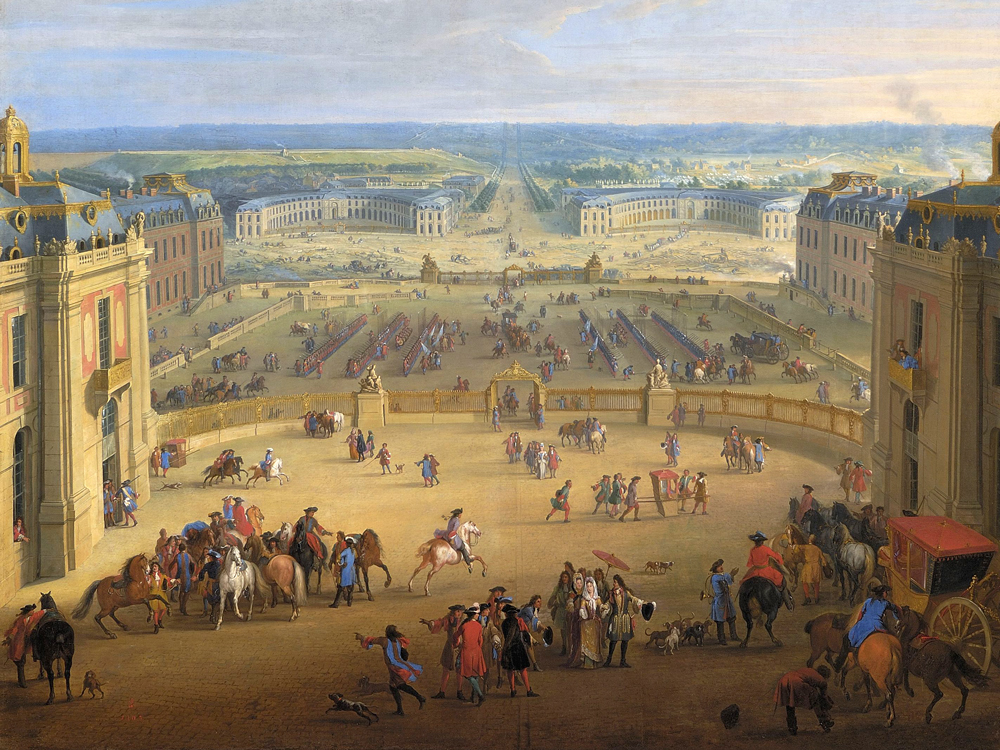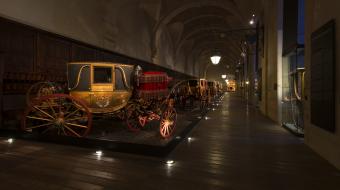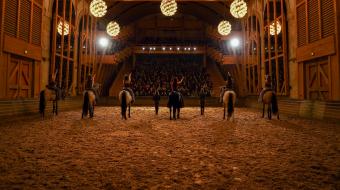OPENING
The Gallery of Coaches is open every Saturday and Sunday from 12:30pm to 5:30pm (last entrance at 4:45pm).
Consult the detailed opening hours
Duration
1 hour
Access
From the Château de Versailles, about 8 minutes on foot, on the town side. Locate the Gallery of Coaches
Ticket
Free access

Work on both buildings was launched in anticipation of the move of the Court and government to Versailles. The project was managed by architect Jules Hardouin-Mansart and was executed by an army of labourers in record time: in just three years, from 1679 to 1682. Louis XIV’s contemporaries were amazed by the scale and majesty of the stables, whose location, opposite the Palace, testifies to the important role of horses in the representation of power during the Ancien Régime.
The Great and Small Stables are symmetrical buildings on the edge of the Place d’Armes and situated on two trapezoidal plots between the three large avenues in a crow’s foot layout previously laid out by André Le Nôtre. The two buildings are identical in size, but slighlty different in their plans, both built around a main courtyard with a semi-circle at one end which opened onto an indoor arena. The façades of the stables were both adorned with remarkable sculptural decoration, notably including a group of three galloping horses by Pierre Granier and Jean Raon in the tympanum of the arch in the Great Stables, and a work called the Cocher du cirque (the Circus Driver) by Louis Le Conte in the tympanum of the arch in the Small Stables.

The Great Stables, positioned to the north between Avenue de Saint-Cloud and Avenue de Paris, were managed by the Grand Equerry of France, while the Small Stables, situated to the south between Avenue de Paris and Avenue de Sceaux, were placed under the orders of the First Equerry. The Grand Equerry was an important royal officer who was in charge of all the king’s horses and the equestrian academies, and he also looked after the horses ridden by the king and princes. These saddle horses were perfectly trained for hunting and war. The First Equerry was in charge more generally of all the other mounts and the coach horses, as well as the coaches themselves and other more fantastical vehicles such as the sleds and gondolas.
During the reign of Louis XIV the Royal Stables were one of the most important departments in the King’s House. Nearly 1,500 men worked there, including squires, pages, coachmen, postilions, footmen, lads, messengers, chair bearers, stablemen, blacksmiths, saddlers, tack manufacturers, chaplains, musicians and horse surgeons, creating a constant hive of activity. It was a world unto itself. During the 18th century more than 2,000 horses at any one time were stabled in the Royal Stables.
Today the Royal Stables are home to collections and different establishments such as the National School of Architecture of Versailles, and part of the Centre for research and restoration of the museums of France and the Equestrian Academy of Versailles. Visitors can visit the Gallery of Coaches in the Great Stables and the Sculptures and mouldings gallery in the Small Stables.






